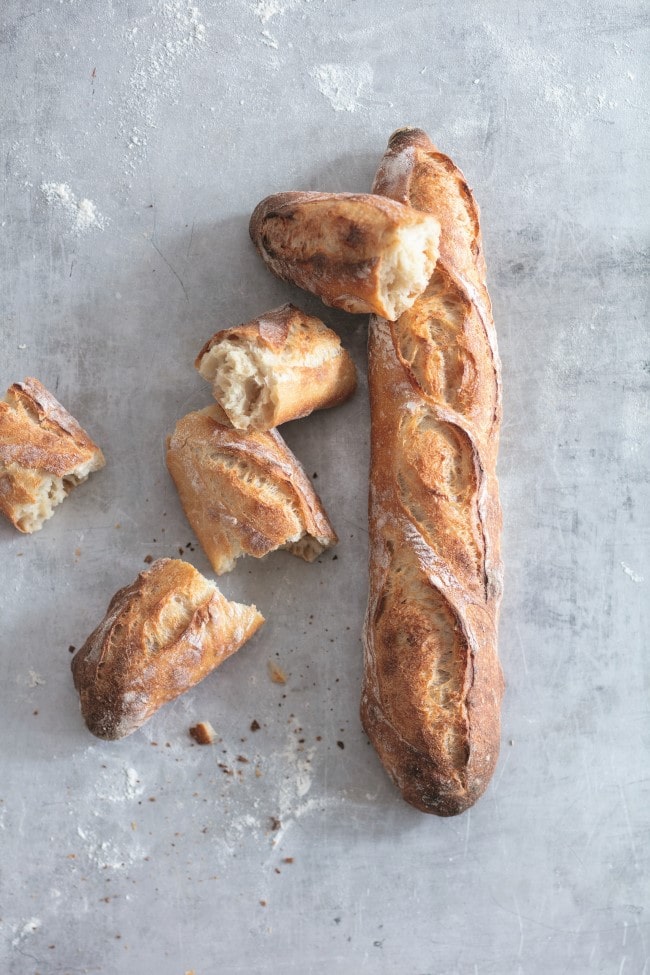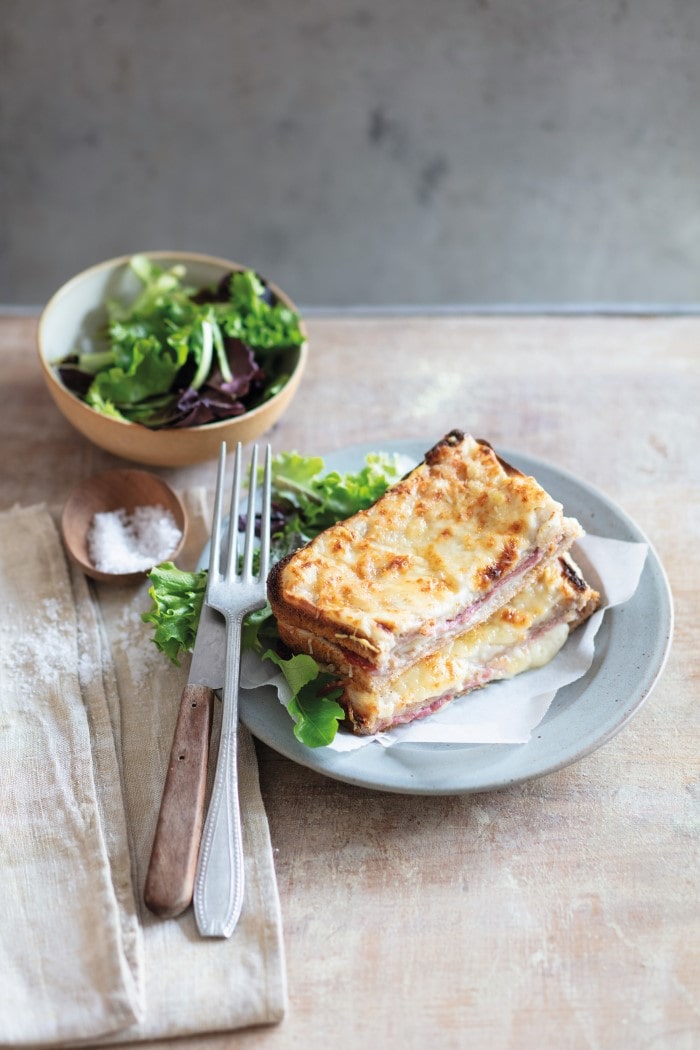Homemade Bread, the French Way

The ultimate bread bible, Upper Crust: Homemade Bread the French Way by Marie-Laure Fréchet, covers everything from the history of bread to grain varieties to mouthwatering recipes, as well as starter doughs and kneading techniques
Excerpted with permission from Flammarion. Photography by Valérie Lhomme.
FOUGASSE
Makes 1 large or 2 small fougasses
Active time: 20 minutes
Bulk fermentation: 2 hours
Resting: 30 minutes
Proofing: 1 hour
Cooking: 15–18 minutes
INGREDIENTS
2/3 cup (9oz/160g) water
1 tsp (0.2oz/5g) salt
2 cups (9oz/250g) bread or white whole wheat
flour (T65–T80)
0.2oz (5g) fresh yeast
2 tsp (5g) dried herbs and/or spices (thyme, oregano, herbes de Provence, etc.)
2 tbsp (1oz/30g) extra-virgin olive oil + 1 tbsp (0.5oz/15g) for brushing
1.75oz (50g) pitted and coarsely chopped olives and/or thinly sliced sundried tomatoes (optional)
Toppings (optional)
1.75oz (50g) bacon, cut into thin strips (lardons)
Grated Emmental cheese
METHOD
1 Place the water, salt, and flour in the bowl of a stand mixer fitted with the dough hook. Crumble in the yeast in very small pieces and add the herbs/spices. Knead for 5 minutes on speed 1, followed by 5–7 minutes on speed 2. About halfway through the 5–7 minutes, drizzle in the 2 tbsp (1oz/30g) olive oil with the mixer running. At the end of the kneading time, add the olives and/or sundried tomatoes, if using, and mix for 1 minute on speed 1, until well incorporated.
2 Cover the bowl and let the dough rise in a warm place for 2 hours. Fold the dough twice during the rise time (bulk fermentation).
3 Meanwhile, if you’d like to top your fougasse with bacon, fry the bacon in a skillet until browned and crisp. Drain on paper towels and let cool completely before using.
4 Turn the dough out onto a floured work surface. For two fougasses, divide the dough into two equal pieces using a bench scraper. Shape each piece into a bâtard, cover with a damp towel, and let rest for 30 minutes.
5 Using the palm of your hand or a rolling pin, flatten the dough into one or two ovals with a thickness of about ¾ in (2 cm). Place on a baking sheet lined with parchment paper. Using a bench scraper or a spatula, make several diagonal slits in the dough, cutting all the way through and making a pattern that resembles a palm leaf. Stretch the slits open with your fingers, making them wide so that they won’t close up during baking. Cover with a damp towel and let rise at room temperature for 1 hour (proofing).
6 If you’re adding toppings, brush the dough with water to moisten it and sprinkle with the bacon and/or cheese.
7 Toward the end of the rising time, preheat the oven to 450°F (230°C/ Gas Mark 8).
8 When the dough passes the poke test* (see below), bake the fougasse(s) for 15–18 minutes, until golden. Slide onto a rack with the parchment paper underneath and brush with a little olive oil.
9 Serve warm or at room temperature.
POKE TEST
If the proofing time is too short, the dough won’t build up enough CO2 to rise correctly during baking. Conversely, if the proofing time is too long, the gluten network weakens and the bread may fall during baking. Even professional bakers use the poke test to evaluate the dough’s resistance and determine when it is ready for the oven.
Gently press your finger about ½ in (1 cm) into the dough. If the dough is ready to bake, it will spring back slowly but retain a small indentation where you poked it. If no indentation forms, the dough is not ready; leave it to proof a little longer. If the indentation doesn’t spring back at all, it’s too late – the dough is over-proofed.

Upper crust baguette © Valerie Lhomme
BAGUETTES
Makes 4 small baguettes
Active time: 15 minutes
Autolyse: 3 hours
Bulk fermentation: 1½ hours + 15 hours
Resting: 30 minutes
Proofing: 30 minutes
Cooking: 18 minutes
EQUIPMENT
Paline (baguette transfer peel)
INGREDIENTS
4 cups + 2 tbsp (1lb 2oz/500g) bread flour (T65)
Scant 1½ cups (12.5oz/350g) water + 2 tsp
(0.35oz/10g) for dissolving salt
1.75oz (50g) refreshed levain
0.05oz (1g) fresh yeast
Scant 1½ tsp (0.25oz/7g) salt
METHOD
1 A day before baking, place the flour and scant 1½ cups (12.5oz/350g) of water in the bowl of a stand mixer fitted with the dough hook. Mix for 1 minute on speed 1 (frasage*). Cover the bowl and let the mixture rest for 3 hours (autolyse*).
2 Add the levain and crumble in the fresh yeast. Combine the salt and 2 tsp (0.35oz/10g) water in a bowl and stir or swish to dissolve, then add to the dough. Knead for 8 minutes on speed 1.
3 Cover the bowl and let the dough rise for 1½ hours. Fold the dough three times during the rise time: once after 30 minutes, once after 1 hour, and once after 1½ hours. Cover and place in the refrigerator for 15 hours (bulk fermentation).
4 The next day, dust a work surface and the dough with flour. Turn the dough out onto the work surface, floured side down. With a bench scraper, divide dough into four equal pieces. Shape each piece into a rough oval and let rest at room temperature for 30 minutes.
5 Shape each piece of dough into an approximately 10-in. (25-cm) baguette, ensuring it will fit in your oven lengthwise (the baguettes will be easier to transfer to the oven if they’re shorter). Place the shaped baguettes between the folds of a floured couche, or flour a towel and pleat it like an accordion around the baguettes. Let them rest for 30 minutes (proofing).
6 Meanwhile, place a rack at the lowest oven position and place another rack directly above it. Place an empty heavy-duty baking sheet, oven-safe skillet, or drip pan on the lower rack, and a baking stone or heavy-duty baking sheet on the upper rack, and preheat the oven to 500°F (260°C/Gas Mark 10). Bring 1 cup (250ml) of water to a simmer.
7 When the dough passes the poke test, using a bread lame, slash each baguette diagonally in two places. Roll the baguettes one at a time onto the paline and carefully transfer to the baking stone or sheet in the oven.
8 Carefully pour the simmering water into the baking sheet, skillet, or drip pan to create steam and quickly close the oven door.
9 Bake for 18 minutes, lowering the oven temperature to 450°F (240°C/Gas Mark 8) halfway through the baking time.
10 Remove the baguettes from the oven and place on a rack to cool.

Vienna bread with chocolate chips © Valerie Lhomme
VIENNA BREAD WITH CHOCOLATE CHIPS
Makes 2 small baguettes
Active time: 20 minutes
Bulk fermentation: 1 hour
Resting: 15 minutes
Proofing: 1–1½ hours
Cooking: 20–30 minutes
INGREDIENTS
2/3 cup (5.25oz/150g) whole milk
0.25oz (7g) fresh yeast
1.75oz (50g) refreshed levain
1 generous tbsp (15g) sugar
2 cups (9oz/250g) bread flour (T65)
1 tsp (0.2oz/5g) salt
3 tbsp (1.5oz/40g) butter, diced, at room temperature
Generous ½ cup (3.5oz/100g) chocolate chips, or 1 (3.5oz/100g) chocolate bar, roughly chopped
1 egg yolk, lightly beaten
METHOD
1 Pour the milk into the bowl of a stand mixer fitted with the dough hook. Crumble in the fresh yeast and stir or swish to dissolve, then stir in the levain. Add the sugar, flour, and salt. Knead for 10 minutes on speed 1, followed by 5–10 minutes on speed 2, until the dough pulls away from the sides of the bowl. About halfway through the 5–10 minutes, add the butter with the mixer running. Add the chocolate chips and knead briefly until evenly distributed.
2 Shape the dough into a ball, place it in a lightly oiled or flour-dusted bowl, and cover. Let rise for 1 hour in a place that is warm, but not warm enough to melt the chocolate (bulk fermentation).
3 Turn the dough out onto a floured work surface and divide it into two equal pieces. Cover with a towel and let rest for 15 minutes.
4 Shape each piece of dough into a short baguette and place seam-side down on a baking sheet lined with parchment paper.
5 Brush the dough with a thin layer of egg yolk, then chill in the refrigerator for 10 minutes to firm it up a bit. Brush with another layer of egg yolk and score with kitchen shears, making several parallel diagonal cuts across the top of the dough.
6 Let rise in a warm place for 1–1½ hours (proofing).
7 Toward the end of the rising time, place a rack in the centre of the oven and place another rack directly below it. Place an empty heavy-duty baking sheet, oven-safe skillet, or drip pan on the lower rack and preheat the oven to 400°F (200°C/Gas Mark 6). Bring 1 cup (250ml) of water to a simmer.
8 When the dough passes the poke test* (see page 70), place the baking sheet in the oven, then carefully pour the simmering water into the baking sheet, skillet, or drip pan to create steam and quickly close the oven door.
9 Bake for 20–30 minutes, until deeply golden. Slide the bread onto a rack with the parchment paper underneath and let cool.
LA BONNE IDÉE
You can swap out the chocolate chips for dried fruit of your choice, such as raisins or a blend of tropical fruits.

Croque monsieur © Valerie Lhomme
CROQUE MONSIEUR
Makes 4 sandwiches
Active time: 30 minutes
Cooking: 10 minutes
INGREDIENTS
Béchamel
2 tbsp (30g) butter
3 tbsp (1oz/30g) flour
1¼ cups (300ml) whole milk
Salt and freshly ground pepper
Ground nutmeg
ASSEMBLY
8 slices pain de mie (Pullman Loaf)
5.25oz (150g) Comté or Emmental cheese,
freshly grated
2 relatively thick slices ham, halved
METHOD
1 Prepare the béchamel: Melt the butter in a saucepan over low heat. Add the flour and cook for a few minutes, stirring nonstop, without letting the mixture brown. Gradually pour in the milk, whisking constantly to avoid lumps. Cook, stirring nonstop, until the béchamel begins to bubble and thicken. When it is thick and creamy, remove it from the heat and season with salt, pepper, and nutmeg to taste. Pour into a bowl, press plastic wrap over the surface, and let cool completely before using.
2 Assemble and bake the croque monsieurs: Preheat the oven to 350°F (180°C/Gas Mark 4) and line a baking sheet with parchment paper.
3 Divide two-thirds of the béchamel between the eight slices of pain de mie and spread into an even layer. Sprinkle with grated cheese, saving some for the tops of the sandwiches. Place four of the slices on the prepared baking sheet, béchamel-side up. Cover each slice on the baking sheet with a half-slice of ham. Top with the remaining pain de mie, béchamel-side down. Press down firmly with the palm of your hand.
4 Cover the croque monsieurs with the remaining béchamel and grated cheese. Bake for about 10 minutes, until golden.
5 Serve hot with green salad on the side.
For more recipes, click here
As seen in France Today Magazine
Share to: Facebook Twitter LinkedIn Email
More in bread, bread making, French food, recipes
Leave a reply
Your email address will not be published. Required fields are marked *




REPLY